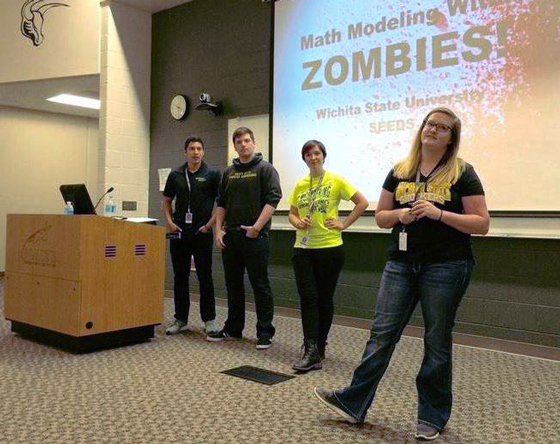Students at local high schools are being challenged by a team of Wichita State University engineering students to come up with a plan to survive a zombie attack. The presentation is part of an activity designed to teach the value of math modeling in solving complex problems with limited resources.
The zombie scenario uses a complex formula where students are given fixed rates for time needed to prepare and store food, water and bullets necessary for survival, as well as expected kill rates for shooting zombies and rate of zombie encroachment over time. (As every horror aficionado knows, zombies attack at an exponentially increasing rate.)
The math model is embedded in a spreadsheet that calculates days of survival based on how much time one chooses to allocate to gathering food, water or bullets. Those who calculate wrong risk dying from dehydration, starvation or zombie attack.
“The presentation really drives home the point that before you spend any time preparing food, water or bullets, you would really be well-served to spend a few minutes doing some math first,” said Polly Basore, K-12 outreach coordinator for the College of Engineering.
Positive feedback
The presentation is put on by WSU engineering students working for the College of Engineering’s program known as SEEDS (Science and Engineering Education Development for Students). The SEEDS program presents hands-on science activities designed to foster an interest in engineering through Saturday workshops, after-school programs, classroom visits, field trips and special events, such as school science nights and career days. During the 2013-14 academic year, SEEDS hosted 109 events involving approximately 3,000 children.
The primary audience for SEEDS programs is middle school, but the Zombie Math Modeling activity is part of a new push to reach out to high school students in advanced math and science classes. So far, the Zombie Math Modeling activity has been presented to students at North, Northeast, Heights, Maize South and Bishop Carroll high schools.
“I thought it went great,” said Eric Weber, a Bishop Carroll science teacher who had the WSU students present to his freshmen classes last week. “My classes seemed to enjoy themselves, and many of them displayed a pretty impressive ability to apply math to the problem. I received nothing but positive feedback after (the WSU students) left.”
Students helping students
WSU engineering students hired to work for SEEDS are chosen for their ability to serve as role models to children who may be unfamiliar with what it means to be an engineer. WSU students participating in the zombie activity at Bishop Carroll included Emilio Rocha (mechanical engineering), Sanjuana Martinez (biomedical engineering), Amber Fischer (aerospace engineering) and Austin White (computer engineering).
The math model used in the activity was developed last year by Josue Palacios, a former SEEDS employee who received bachelor’s degree in bioengineering in May and is now pursuing a doctorate at Georgia Tech. Palacios uses complex math models in his research to predict the durability of biomedical implants.
The College of Engineering’s K-12 Outreach programs are supported by corporate donors and the state through the University Engineering Initiative Act, passed in 2011 as part of an effort to boost the Kansas economy by addressing a workforce shortage of engineering graduates.
To learn more, go to wichita.edu/engineeringK12outreach. To request the Zombie Math Modeling presentation at your school, go to goo.gl/ncBlZr.


 Courtesy
Courtesy